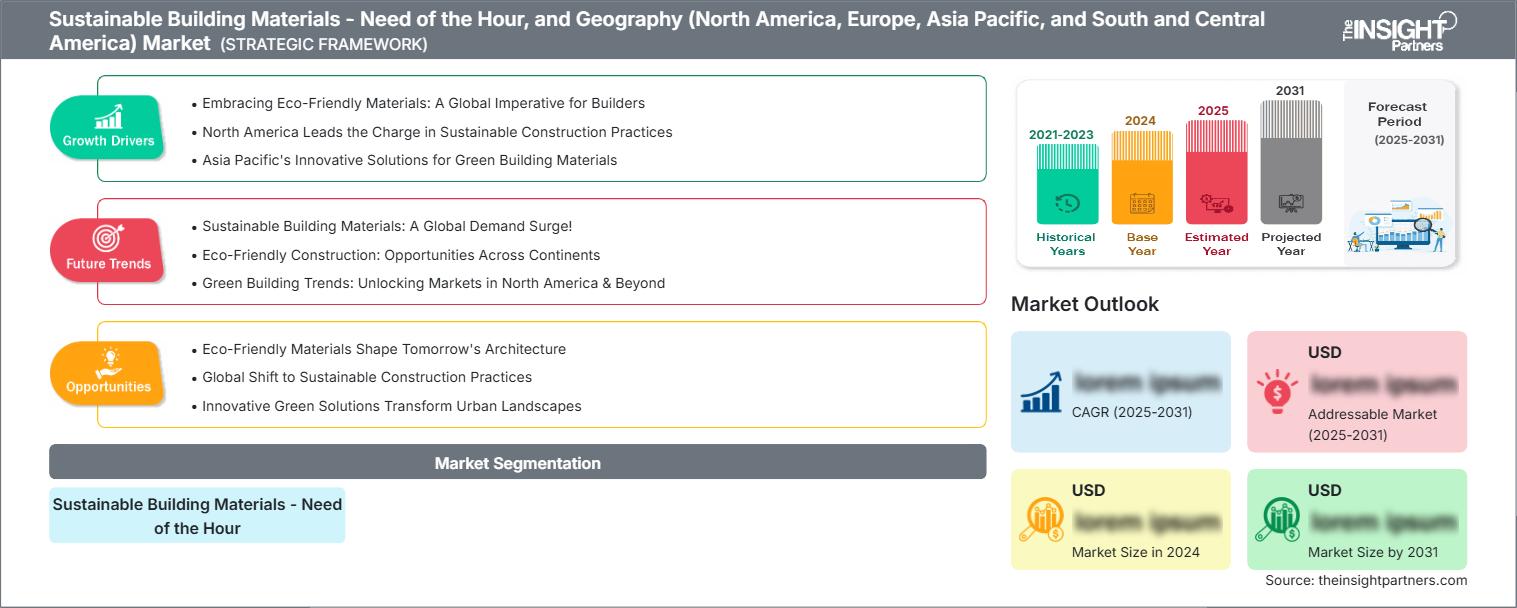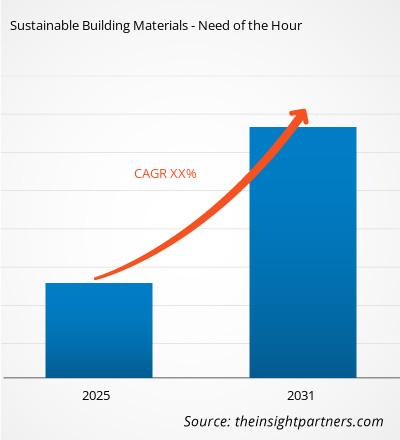L'edilizia contribuisce in modo significativo allo sviluppo socioeconomico nella maggior parte dei paesi e rappresenta la maggior parte del consumo energetico. L'edilizia e le costruzioni sono responsabili di notevoli emissioni di gas serra e quindi spingono verso metodi di costruzione più sostenibili. Per questo motivo, i materiali da costruzione sostenibili hanno acquisito importanza nel settore edile globale. I materiali da costruzione sostenibili sono anche chiamati materiali da costruzione ecologici, efficienti dal punto di vista energetico e durevoli. I materiali da costruzione sostenibili contribuiscono a creare condizioni ambientali confortevoli e salutari durante tutto il ciclo di vita dell'edificio. L'obiettivo principale dei materiali da costruzione sostenibili è raggiungere un uso efficiente di energia, acqua e materie prime e ridurre al minimo l'impatto ambientale degli edifici. Tuttavia, a causa della complessità dell'implementazione della sostenibilità e della frammentazione del settore, il livello di implementazione dei materiali da costruzione sostenibili è ancora in fase iniziale.
Riceverai la personalizzazione gratuita di qualsiasi report, incluse parti di questo report, analisi a livello nazionale, pacchetto dati Excel e potrai usufruire di fantastiche offerte e sconti per start-up e università.
Materiali edili sostenibili: necessità del momento e geografia (Nord America, Europa, Asia Pacifico e Sud e Centro America) Mercato: approfondimenti strategici

-
Scopri le principali tendenze di mercato di questo rapporto.Questo campione GRATUITO includerà analisi dei dati, che spaziano dalle tendenze di mercato alle stime e alle previsioni.
Si prevede che la crescente domanda di città e infrastrutture sostenibili, dovuta all'evoluzione del settore edile, darà impulso al mercato dei materiali da costruzione sostenibili. Le grandi imprese edili mirano a realizzare edifici certificati sostenibili a costi finanziari e ambientali ridotti. Negli Stati Uniti, il programma Leadership in Energy and Environmental Design (LEED) del Green Building Council ha introdotto un nuovo approccio per i materiali e i prodotti da costruzione, ampliandone il ruolo nel processo di certificazione, dal punto di produzione al termine del ciclo di vita dell'edificio. Grazie all'avvento della digitalizzazione e dell'automazione nella maggior parte dei settori, l'industria edile può trasformarsi integrando la tecnologia digitale e l'automazione avanzata negli edifici e nelle infrastrutture. Con il 30-40% dei rifiuti solidi generati dall'ambiente edificato, i materiali da costruzione sostenibili offrono un'importante opportunità al settore edile per ridurre i costi, preservare le risorse e proteggere l'ambiente. I principali materiali utilizzati come materiali da costruzione sostenibili includono isolamento termico ecologico, metallo riciclato, legno di recupero, bambù, calcestruzzo cellulare isolante, vetro riciclato, ecc. Si tratta di materiali ecocompatibili e a basso impatto ambientale durante la produzione, l'implementazione e la manutenzione. Si tratta per lo più di materiali riciclabili e di provenienza locale. Le aziende stanno puntando a realizzare edifici a zero emissioni di carbonio e a ottimizzare le prestazioni del ciclo di costruzione utilizzando questi materiali edili sostenibili. Sul mercato vengono introdotti materiali sempre più ecologici, riducendo significativamente i costi energetici nell'edilizia residenziale e commerciale.
Materiali edili sostenibili: necessità del momento e geografia (Nord America, Europa, Asia Pacifico e America meridionale e centrale) Approfondimenti di mercato regionali
Le tendenze regionali e i fattori che influenzano il mercato dei Materiali da Costruzione Sostenibili - Esigenza del momento e Geografia (Nord America, Europa, Asia Pacifico e America Meridionale e Centrale) durante il periodo di previsione sono stati ampiamente spiegati dagli analisti di The Insight Partners. Questa sezione illustra anche i segmenti di mercato e la geografia dei Materiali da Costruzione Sostenibili - Esigenza del momento e Geografia (Nord America, Europa, Asia Pacifico e America Meridionale e Centrale) in Nord America, Europa, Asia Pacifico, Medio Oriente e Africa e America Meridionale e Centrale.
Materiali edili sostenibili: necessità del momento e ambito del rapporto di mercato geografico (Nord America, Europa, Asia Pacifico e Sud e Centro America)
| Attributo del report | Dettagli |
|---|---|
| Dimensioni del mercato nel 2024 | XX milioni di dollari USA |
| Dimensioni del mercato entro il 2031 | XX milioni di dollari USA |
| CAGR globale (2025 - 2031) | XX% |
| Dati storici | 2021-2023 |
| Periodo di previsione | 2025-2031 |
| Segmenti coperti | Materiali edili sostenibili - Esigenza del momento |
| Regioni e paesi coperti |
America del Nord
|
| Leader di mercato e profili aziendali chiave |
|
Materiali edili sostenibili: esigenza del momento e geografia (Nord America, Europa, Asia Pacifico e America meridionale e centrale) Densità degli operatori di mercato: comprendere il suo impatto sulle dinamiche aziendali
Materiali edili sostenibili: esigenza del momento e geografia (Nord America, Europa, Asia-Pacifico e America Centrale e Meridionale) Il mercato è in rapida crescita, trainato dalla crescente domanda degli utenti finali, dovuta a fattori quali l'evoluzione delle preferenze dei consumatori, i progressi tecnologici e una maggiore consapevolezza dei vantaggi del prodotto. Con l'aumento della domanda, le aziende stanno ampliando la propria offerta, innovando per soddisfare le esigenze dei consumatori e capitalizzando sulle tendenze emergenti, alimentando ulteriormente la crescita del mercato.

- Ottieni la panoramica dei principali attori del mercato dei materiali da costruzione sostenibili: necessità del momento e geografia (Nord America, Europa, Asia Pacifico e Sud e Centro America)
Il Nord America e l'Europa sono tra i principali utilizzatori di materiali edili ecologici o sostenibili. Più della metà delle imprese edili ha implementato la bioedilizia nei propri progetti. Tuttavia, i paesi in via di sviluppo come l'India non dispongono di incentivi per l'edilizia sostenibile. Lentamente e costantemente, i consumatori si stanno orientando verso case ecologiche, contribuendo a promuovere materiali edili sostenibili. In India, il Green Building Code ha stabilito codici e standard nei regolamenti statali e nelle norme stabilite dai programmi di valutazione, come LEED-India, l'Indian Green Building Council (IGBC), TERI-GRIHA e altre certificazioni simili. È importante che l'attuazione di queste politiche sia efficace e che i costruttori commerciali ottengano agevolazioni fiscali e permessi rapidi sotto forma di incentivi.
L'impatto dell'edilizia dura decenni e riguarda sia le generazioni attuali che quelle future; pertanto, è fondamentale adottare materiali edili sostenibili che abbiano un impatto positivo sull'ambiente durante la costruzione e dopo il ciclo di vita dell'edificio.
- Analisi storica (2 anni), anno base, previsione (7 anni) con CAGR
- Analisi PEST e SWOT
- Valore/volume delle dimensioni del mercato - Globale, Regionale, Nazionale
- Industria e panorama competitivo
- Set di dati Excel
Report recenti
Testimonianze
Motivo dell'acquisto
- Processo decisionale informato
- Comprensione delle dinamiche di mercato
- Analisi competitiva
- Analisi dei clienti
- Previsioni di mercato
- Mitigazione del rischio
- Pianificazione strategica
- Giustificazione degli investimenti
- Identificazione dei mercati emergenti
- Miglioramento delle strategie di marketing
- Aumento dell'efficienza operativa
- Allineamento alle tendenze normative






















 Ottieni un campione gratuito per - Materiali edili sostenibili: necessità del momento e geografia (Nord America, Europa, Asia Pacifico e Sud e Centro America)
Ottieni un campione gratuito per - Materiali edili sostenibili: necessità del momento e geografia (Nord America, Europa, Asia Pacifico e Sud e Centro America)